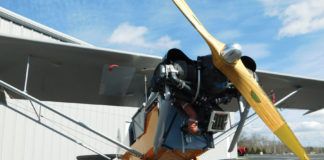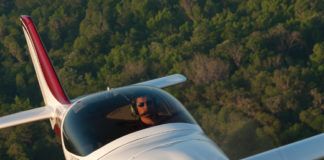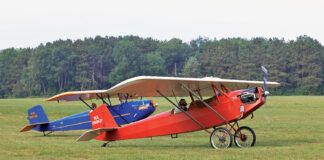BY STEIN BRUCH All About Avionics, Part 7
Do you really need an IFR-approved GPS navigator?
If you do, which one is best? Answers forthwith.
Thanks to this crazy little thing called WAAS-shorthand for Wide Area Augmentation System-using GPS for instrument navigation has become a hot thing. With WAAS, GPSes now have unprecedented accuracy, enough so that the simple lateral guidance we have enjoyed for a decade or more is supplemented with vertical guidance, a glideslope created right in the box. A WAAS navigator is on just about every instrument pilots wish list.
But there remain questions, and one from the Experimental side of the lawn we hear often is: Do I need an IFR GPS to fly IFR in my plane? Don’t look to FAR 91.205 for a clear answer because the only statement there says you need …navigational equipment appropriate to the ground facilities to be used. Here is the short and simple answer: If you intend to fly non-precision or precision GPS approaches, then yes, really, you do need an IFR GPS. (For more on this topic, see Is Your Navigation Equipment IFR Legal? in the PDF version) While we know pilots have used the waypoints in a portable or panel-mount VFR box to fly published GPS approaches, this is, we think, a patently foolhardy procedure. So, thats settled. If you’re going to be a good citizen in the IFR world, you need the proper box, properly installed, and packing a current database.
Much More than Plug and Play
Now that you’ve installed your IFR GPS in the plane, you’re legal to go out and fly all those new whizbang approaches, right? Wrong! The fact is, simply buying the unit is only the first step in making your airplane legal with these boxes. To ensure your installation meets legal muster there are a number of things to consider from both a practicality and legality standpoint. The installation of the GPS (WAAS or not) must conform to both the manufacturers approved installation manual and FAA guidelines. The FAA Advisory Circular that covers GPS installations is AC 20-138.
Jason Smith and Gary Wirrell from Aerotronics, along with Jake Hookham and David Buckwalter from Avionics Systems have probably installed more GPSes into Experimental aircraft than most of us are likely to see in a lifetime, and together we have all come to interpret the regulations in the same manner. It is our position that to comply with the aforementioned requirements as well as AC 20-138, most GPSes must be physically installed in an FAA-approved or manufacturer-approved location, which is within view and reach of the pilot (as specified in the manufacturers installation manual). Additionally, any required annunciation as well as the course-guidance instrument (CDI or HSI) must also be installed in the pilots primary field of view.
Some manufacturers detail additional requirements in their respective installation manuals. For example, guidance for the Garmin GNS530W specifically dictates the display must be positioned within 13.8 inches of pilot centerline of vision in order to use the internally displayed annunciators. Garmin goes on to state that if you use a CDI/HSI (for many of us that means EFISes) with built-in nav annunciation, then that unit must be within 16.8 inches of the pilot centerline of vision. The result is that we all agree there isn’t an end all specification for installing any IFR GPS in a plane. The only way to be sure is to follow the recommendations of each manufacturer.
Annunciation Now!
Speaking of annunciation and indicators, what is required? Well, this also can vary wildly from unit to unit, and manufacturer to manufacturer. Some units (such as the new GNS series from Garmin) have built-in annunciation that will fulfill requirements as long as the units are installed per the manufacturers recommendations. Other units, such as the King KLN94 require external annunciators/switches to comply. Factor these differences into your budgeting.
When it comes to indicators such as a CDI or HSI, the water becomes a bit muddier. Again, the manufacturers installation instructions must be adhered to. In general, for VFR installations, no external CDI or HSI is required; for IFR installations, a CDI/ HSI is normally required. Because a large majority of homebuilts and Experimental aircraft are now using EFISes for primary flight and navigation information, it makes sense to integrate your IFR GPS with these units. Again, you’ll need to find out specifically from your EFIS manufacturer whether their units will integrate with your IFR GPS and provide the required functionality. Im not trying to avoid answering the question, but with such differing requirements, there is no one answer.
For example, some GPSes output lateral course guidance on the RS-232 data bus, which would work with the vast majority of glass panels. But some feed either an ARINC 429 data stream or require a resolver input back to the GPS, and not all glass panels provide this output. Some installations need both. (Incidentally, the Garmin 400/500 series outputs GPS lateral guidance on the RS-232 bus, but not VOR/ILS information nor the vertical guidance in the W models.) Contact the manufacturer of the EFIS you’re thinking of purchasing to find out if itll integrate with the IFR GPS you might be installing.
The physical operation and use of GPSes for IFR navigation is now covered by an Advisory Circular from the FAA: AC 90-100A. This is the revised version of the AC that caused some mild panic in the community earlier this year regarding the use of IFR GPSes for flight. The updated AC has been revised to more clearly communicate the position of the FAA with regard to the actual flight operation of GPSes in the IFR environment. (All of the FAA advisory circulars can be found at www. airweb.faa.gov.)
Now for the real bugger of a question: Which box should you buy, and which one is better? While there are a number of IFR GPSes available for non-precision approaches, only a handful are fully certified to the highest WAAS level, and those are the Garmin 400W/500W series, as well as the GNS 480 (previously the CNX 80) and now the G900X/ G1000 integrated fl ight systems. Garmin is really the only choice for WAAS-certified boxes, but both Bendix/King and Garmin also manufacture non-WAAS, IFR-certified boxes.
Bendix/King
KLN94. This color GPS-only unit is an updated version of the monochrome KLN89B. It is IFR certified for non-precision approaches, as well as enroute and terminal navigation. It has a basic moving-map display and will integrate with the KX155/165A radios for loading of frequencies, and can also be integrated into the KMD series of multi-function displays (MFDs). The KLN94 is a definite improvement over older generation boxes from King. However, since its not WAAS certified, functionality in the modern IFR environment will be limited, in our opinion. In comparing units based on customer preferences, this box lags well behind competing units. To give you a perspective, we’ve installed exactly one of these units in the past three years. As this is being written, the KLN94 is the company’s top box, but rumors persist that the company will have a new unit at Oshkosh.
Price: $5000.
Pros: One of the lower cost certified IFR color displays available…
Cons: …but watch out for add-on costs of a resolver CDI and external annunciator. Outdated with limited functionality for the cost.
Garmin
GPS 155XL TSO. This panel-mount GPS is only IFR certified for enroute and non-precision approaches. Even though the display is monochrome, its fairly easy to read. In our experience, few customers actually end up installing this unit because for not much more money you can upgrade to a unit (GNC 300XL TSO) with a built-in com transceiver.
Price: $4375.
Pros: Entry-level, IFR-certified, GPS-only box thats reasonably priced.
Cons: Limited functionality and monochrome display.
GNC 300XL TSO. Expanding on the GPS 155XL TSO, the GNC 300XL TSO adds a communication transceiver from which frequencies can be loaded and transferred from the GPS database. This unit has been fairly popular, as it frequently can be found in refurbished condition for a significantly lower price. It also integrates nicely with some popular EFISes. A combination we oft en see is a GNC 300XL paired with the Grand Rapids Technologies Horizon series EFIS. We’ve also found the built-in com transceiver to be of good quality, and having the capability to load frequencies into the radio direct from the GPS is something that will spoil you once you use it!
Price: $5215.
Pros: Nice IFR-certified, panel-mount GPS com. Can be found overhauled for a reasonable price.
Cons: Monochrome display, and requires external annunciator in certain installations.
GNS 430W. The ubiquitous GNS 430 gets an upgrade and is now WAAS Class 3 IFR certified (which allows the pilot to fly all published WAAS GPS approaches). As always, the GNS series is easy to use and easy to navigate around. The 3.3-inch color display is on the small side, but with the ability to declutter and zoom, you wont find it an issue. The 400W series is available with or without nav and com transceivers as options, but the majority of customers choose the 430W, which includes an integrated nav and com. The GNS series integrates with many other units, including secondary GNS units, transponders, EFISes, XM weather and music boxes, the GMX 200 and many more optional items. We’ve found the new generation of GNS 430s to be more popular than ever.
Price: $8000.
Pros: New updates make this box a great value. Ease of use, proven reliabil-ity with lots of units in the field. Great interconnectivity with other avionics.
Cons: Box is somewhat deep; screen size is small. Resolution could be better.
GNS 530W. The GNS 530W could be called the big brother to the 400 series. It also includes an integrated 10-watt (16-watt optional) nav/com transceiver, but other variations of the 500W series are available without nav or com radios. Perhaps the most noticeable diff erence is the larger 5-inch screen, which allows for more information to be displayed while still remaining fairly legible. Everything we said about the 430 applies to the 530, but one major advantage is sheer screen size. When you have satellite weather connected to this box, the larger display is really nice to have. Likewise, with the terrain depiction. Its a bit more money to upgrade from the 430, but if you don’t have an EFIS screen in the plane or another MFD of any sort, you’ll find the larger screen size of the 530 to be a tremendous benefit. We’ve seen use of the 530 now grow in popularity to the point where we are installing more 530s than 430s in our shop.
Price: $13,000.
Pros: Larger screen makes for excellent readability. the WAAS capability makes situational awareness a breeze.
Cons: The large screen that makes this box so nice is also its Achilles heel; installation can be challenging in some aircraft .
GNS 480. Offering a fully integrated nav/com radio, the 480 also integrates nicely with the GMX 200 MFD. In size the 480 fits in between the 400 and 500 series, but is quite a different box. The 480 was WAAS IFR certified before the 400/500 series and offers some unique features not found on that series. The most obvious difference is the inclusion of airways in the 480, allowing the serious IFR pilot to navigate within the system easily when routed on airways. The menu structure and navigation is also different from the 400/500 series. Not necessarily more difficult, but certainly different. Another huge benefit in our opinion is the ability of the 480 to remotely control either a Mode C (GTX 32) or Mode S (GTX 33) transponder, which increases usable space in the instrument panel. This box is also commonly seen paired with a number of EFISes. Until the recent WAAS certification of the 400/500 series boxes, the 480 was the dominant choice for customers seeking an IFR-certified box, and was the most prevalent choice of those installing EFISes. But now that the 400/500 series has been certified, were seeing customers choose those units over the 480 for several reasons. Most state cost as a factor when comparing to the new GNS 430W, as well as the perceived ease of use, which factors into their decision-making.
Price: $9300.
Pros: Airways are a nice addition, and the remote control of transponders is slick. The screen size is a good compromise between the 400/500 series boxes.
Cons: Menu structure can be difficult if you’re used to the 400/500 boxes.
(Note: There is a comparison chart of the different models in the PDF version.)
Wrapping Up
Overall it is obvious that Garmin alone has the lead in IFR GPS boxes. The WAAS upgrade to the 400 and 500 series was a bit overdue, but now that they have arrived, these units off er pilots unparalleled awareness in the IFR environment. When coupled to many of the currently available EFISes and autopilots in the market, they provide an IFR panel packed with capability. Of course, a WAAS GPSs utility depends on what kind of flying you do, and for many day/VFR pilots these navigators are way overkill. But for those who need to work in the system often, or for those who are based at an airport served only by GPS approaches, these boxes are the way to go.













